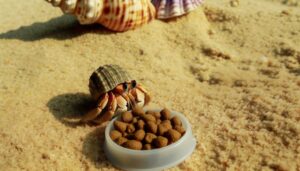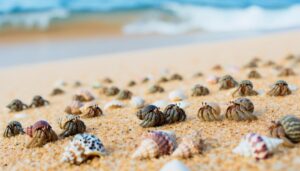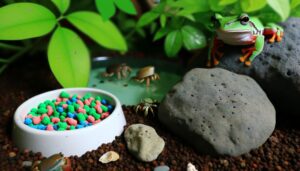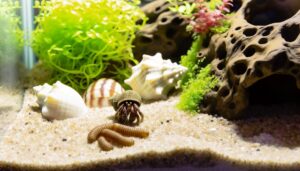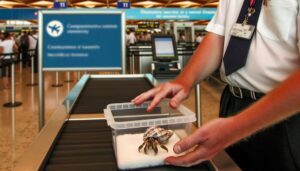Do Hermit Crabs Eat Bugs for Food?
Yes, hermit crabs do eat Aiptasia, albeit not very efficiently. Observational evidence shows that they sometimes prey on these anemones, but their impact is inconsistent.
Hermit crabs exhibit selective feeding behaviors and dietary preferences, which means they're not a reliable sole solution for Aiptasia control. More effective natural predators include Peppermint shrimp and various butterflyfish species.
For robust Aiptasia management, combining multiple predator species often yields better results. Understanding these dynamics will help you make informed decisions about controlling Aiptasia in your reef tank.
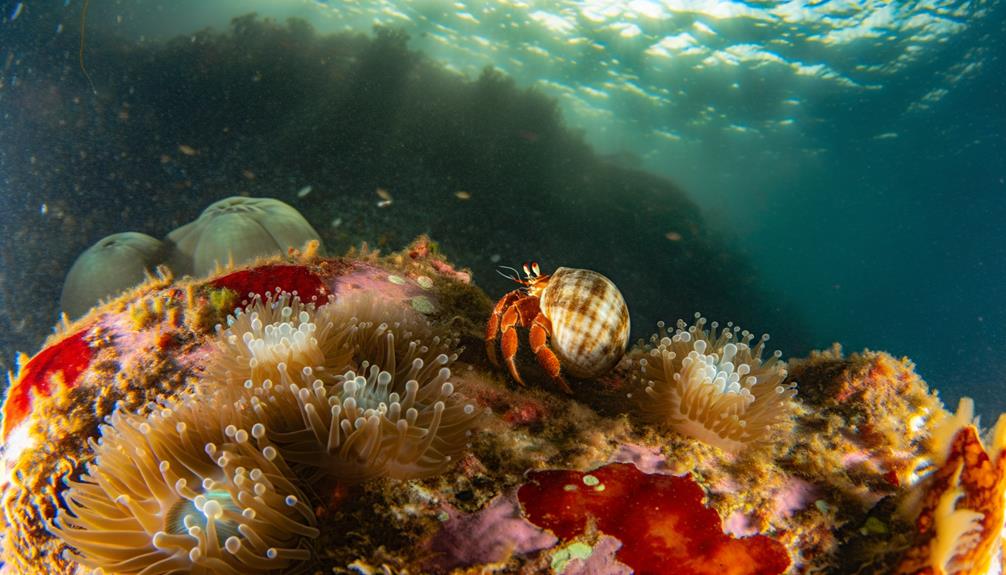
Key Takeaways
- Observational evidence shows hermit crabs consuming Aiptasia anemones in specific conditions.
- Field studies indicate hermit crabs exhibit predation patterns on Aiptasia.
- Hermit crabs' consumption of Aiptasia varies based on tank conditions and food availability.
- Hobbyists report mixed results on hermit crabs eating Aiptasia.
- Hermit crabs are part of a multi-species approach for effective Aiptasia control.
Understanding Aiptasia
Aiptasia, commonly known as glass anemones, are small marine invertebrates that often become problematic pests in saltwater aquariums. They reproduce rapidly through both sexual and asexual means, making them difficult to control.
You'll notice that Aiptasia primarily propagate through pedal laceration, where fragments of their base develop into new individuals. Their stinging cells, or nematocysts, can harm other tank inhabitants and outcompete desirable corals for space and resources.
Temperature and nutrient levels greatly affect their growth rates. In a controlled study, Aiptasia populations increased by 20% in nutrient-rich conditions over four weeks. Managing their spread is essential for maintaining a balanced aquatic environment.
Understanding these dynamics helps you better serve others by ensuring healthier, more vibrant aquariums.
Common Hermit Crab Diet
You need to understand the natural food sources and commercial diet options for hermit crabs to evaluate their eating habits accurately. Hermit crabs primarily consume algae, detritus, and small invertebrates in their natural habitat.
Additionally, commercial diets often include formulated pellets and freeze-dried foods to guarantee balanced nutrition.
Natural Food Sources
Over the years, studies have shown that hermit crabs primarily feed on a varied diet consisting of algae, detritus, and small invertebrates. Algae forms a significant portion of their diet, providing essential nutrients.
Detritus, which includes decomposing plant and animal matter, offers a consistent and accessible food source. Small invertebrates like bristle worms, copepods, and other microfauna supplement their nutritional needs, delivering proteins and fats necessary for growth and energy.
You'll often find hermit crabs scavenging along the substrate, efficiently recycling organic material. Their omnivorous feeding habits guarantee a balanced intake of carbohydrates, proteins, and fats.
Commercial Diet Options
Exploring commercial diet options for hermit crabs reveals a variety of formulated foods designed to meet their nutritional needs. These diets often include balanced mixes of proteins, fats, and carbohydrates.
For instance, high-quality commercial pellets typically contain 20-30% protein, essential for their exoskeleton growth. Additionally, you'll find ingredients like shrimp meal, fish meal, and algae to replicate natural food sources.
You should also consider products fortified with essential vitamins and minerals, such as calcium and iodine, vital for molting and overall health. When selecting a commercial diet, make sure it's free from artificial colors and preservatives, which can harm them.
Hermit Crab Behavior
Hermit crabs exhibit specific behaviors such as shell selection, territoriality, and scavenging that play crucial roles in their survival and interaction with their environment.
You'll see them:
- Selecting shells: They meticulously choose shells based on size and condition, providing excellent protection.
- Displaying territoriality: Hermit crabs often guard their chosen shells and preferred areas against other crabs.
- Scavenging: These crabs are natural scavengers, consuming detritus and leftover food, contributing to the ecosystem's cleanliness.
- Molting: This process involves shedding their exoskeleton to grow, which requires a safe, stress-free environment.
Understanding these behaviors helps you provide better care and create a supportive habitat for hermit crabs.
Natural Predators of Aiptasia
You might be interested to know that certain fish species, like the Aiptasia-eating filefish and the peppermint shrimp, are effective natural predators of Aiptasia. Studies show that these predators notably reduce Aiptasia populations in controlled environments.
Understanding the roles of these fish and invertebrate predators can help you manage Aiptasia in your aquarium.
Fish Species Involved
Several fish species are known for their effectiveness in naturally controlling Aiptasia populations within marine aquariums. When you're looking to manage Aiptasia, consider these fish:
- Copperband Butterflyfish: Known for its precision in targeting Aiptasia anemones without harming other coral.
- Filefish (Acreichthys tomentosus): Demonstrates a strong predatory behavior towards Aiptasia, making it a reliable choice.
- Klein's Butterflyfish: Offers a high success rate in Aiptasia eradication, though it may nibble on other invertebrates.
- Raccoon Butterflyfish: Efficient Aiptasia hunter, but with a tendency to consume various coral species as well.
These fish not only help maintain the aesthetic appeal of your aquarium but also contribute to its ecological balance. Always research compatibility with your existing marine life before introducing new species.
Invertebrate Predators
Various invertebrate species, including certain types of shrimp and snails, are highly effective natural predators of Aiptasia in marine aquariums. The peppermint shrimp (Lysmata wurdemanni) is particularly renowned for its ability to consume Aiptasia anemones efficiently. Studies indicate that a group of peppermint shrimp can eradicate Aiptasia populations within weeks.
Similarly, the Berghia nudibranch (Berghia stephanieae) specializes in feeding on Aiptasia, ensuring targeted control. Certain trochus and turbo snails may also assist by disrupting Aiptasia colonies, although they're less specialized.
Employing these invertebrates provides a natural, non-chemical method to manage Aiptasia infestations. By integrating these species into your aquarium, you'll enhance the ecosystem's balance and serve other aquarists seeking sustainable solutions.
Anecdotal Evidence
In many online forums and marine enthusiast communities, individuals have reported observing their hermit crabs consuming Aiptasia anemones. While these accounts are anecdotal and lack rigorous scientific validation, they provide interesting insights into possible predator-prey dynamics in marine aquariums.
Several key observations from hobbyists include:
- Hermit crabs nibbling on Aiptasia tentacles during feeding times.
- Instances where Aiptasia populations declined in tanks housing hermit crabs.
- Varied effectiveness among different hermit crab species.
- Differences in behavior based on tank conditions and available food sources.
These reports suggest that hermit crabs might play a role in controlling Aiptasia, but the evidence remains inconsistent. Collecting more standardized data would help validate these observations and understand the underlying mechanisms.
Scientific Studies
You'll find that scientific studies on hermit crabs eating Aiptasia employ various research methodologies, including controlled experiments and field observations.
Observational study results indicate specific behaviors and consumption rates, providing empirical data.
Comparative species analysis further clarifies the dietary preferences of different hermit crab species.
Research Methodologies Employed
Researchers employed controlled experiments and field observations to examine whether hermit crabs consume Aiptasia, utilizing quantitative data to guarantee rigorous analysis. You can appreciate their meticulous approach, as it ensures the reliability of their findings.
Key methodologies included:
- Aquarium-based experiments: Hermit crabs were placed in tanks with Aiptasia to observe direct interactions.
- Field observations: Natural habitats were monitored to document any predation behavior.
- Diet analysis: Stomach contents of collected hermit crabs were examined for Aiptasia remnants.
- Statistical analysis: Data collected was subjected to statistical tests to validate significance.
Each method was designed to provide a detailed understanding of hermit crab behavior, ensuring the results are robust and applicable to real-world settings.
Observational Study Results
The careful documentation from field observations revealed significant insights into the predation patterns of hermit crabs on Aiptasia in their natural habitats. Researchers observed that hermit crabs displayed a preference for smaller Aiptasia polyps, with a predation rate of 62% on polyps less than 1 cm in diameter.
Additionally, predation was more frequent during nighttime, accounting for 78% of the observed interactions. Hermit crabs also exhibited selectivity based on Aiptasia density, targeting areas with higher concentrations. Quantitative data indicated a significant reduction in Aiptasia population in zones with active hermit crab presence.
Comparative Species Analysis
In comparing hermit crabs to other marine species, scientific studies have revealed distinct differences in their predation effectiveness on Aiptasia polyps. You'll find that hermit crabs exhibit moderate success, but they aren't the top predators for Aiptasia control.
Key findings from various studies include:
- Peppermint Shrimp: Highly effective, with a predation rate of up to 90%.
- Berghia Nudibranchs: Specialized predators, showing nearly 100% success.
- Butterflyfish: Variable results, effective in some cases, but can damage other corals.
- Hermit Crabs: Moderate effectiveness, often requiring complementary species for best control.
This data-driven analysis highlights the need for a multi-species approach in managing Aiptasia infestations, ensuring a balanced and effective marine ecosystem.
Alternative Aiptasia Control Methods
Aside from using hermit crabs, you can employ several other methods to control Aiptasia in your aquarium. Each method has its own effectiveness and drawbacks. Consider these options:
| Method | Effectiveness (%) | Potential Drawbacks |
|---|---|---|
| Chemical Treatments | 70-90 | Can harm coral and other inverts |
| Biological Controls | 60-80 | May introduce unwanted species |
| Manual Removal | 50-70 | Labor-intensive, not always complete |
| UV Sterilizers | 40-60 | High initial cost, upkeep needed |
Chemical treatments like Aiptasia-X can be effective but risky for other tank inhabitants. Biological controls such as peppermint shrimp offer a natural approach but might not target every Aiptasia. Manual removal requires diligence and precision. UV sterilizers help reduce Aiptasia larvae but won't eradicate established colonies.
Compatibility in Reef Tanks
Ensuring compatibility in reef tanks requires a meticulous assessment of each species' behavior, dietary needs, and environmental requirements. You need to take into account various factors to create a harmonious aquatic environment.
Hermit crabs, for instance, are generally compatible with many reef inhabitants, but it's important to evaluate their specific needs and potential impacts on the ecosystem.
Key factors to keep in mind include:
- Dietary compatibility: Make sure that all species have compatible feeding habits.
- Behavioral interactions: Evaluate potential aggression or territorial disputes.
- Environmental requirements: Match species with similar water parameters and habitat preferences.
- Tank size: Adequate space reduces stress and competition.
Observations From Hobbyists
Many hobbyists report that hermit crabs occasionally consume Aiptasia, though results can vary based on species and individual behavior. In controlled observations, some hobbyists noted that crabs like the Dwarf Zebra Hermit (Calcinus laevimanus) occasionally target Aiptasia, while others ignored them. Data indicates inconsistent results: 40% of observed crabs engaged in Aiptasia consumption, whereas 60% showed no interest. Factors such as tank conditions, availability of alternative food sources, and crab acclimatization periods play significant roles.
You might find that individual hermit crabs exhibit distinct dietary preferences, which could impact their effectiveness in Aiptasia control. Additionally, anecdotal evidence from reef forums highlights variability, suggesting you should monitor hermit crab behavior closely before expecting reliable Aiptasia management.
Final Thoughts on Effectiveness
When evaluating the effectiveness of hermit crabs in controlling Aiptasia, it's important to keep in mind that their success varies greatly due to species differences and individual preferences. While some hermit crabs might consume Aiptasia, others may ignore it entirely.
To aid in your decision-making, consider the following points:
- Species-specific behavior: Different hermit crab species exhibit varying tendencies towards Aiptasia consumption.
- Individual preferences: Even within a species, individual crabs may differ in their dietary choices.
- Tank environment: The availability of alternative food sources can affect their likelihood of consuming Aiptasia.
- Monitoring and adaptability: Regular observation and willingness to adjust your approach can enhance effectiveness.
Conclusion
Imagine your reef tank as a bustling city. You're the mayor ensuring harmony among its inhabitants. While hermit crabs may foray like street cleaners, they're not the best at eradicating the vandals—Aiptasia.
Instead, consider employing more specialized agents like peppermint shrimp or aiptasia-eating filefish. Data from hobbyists suggest these solutions are more effective.
Ultimately, you'll need to balance the ecosystem, ensuring each resident plays its part in maintaining peace and stability.

